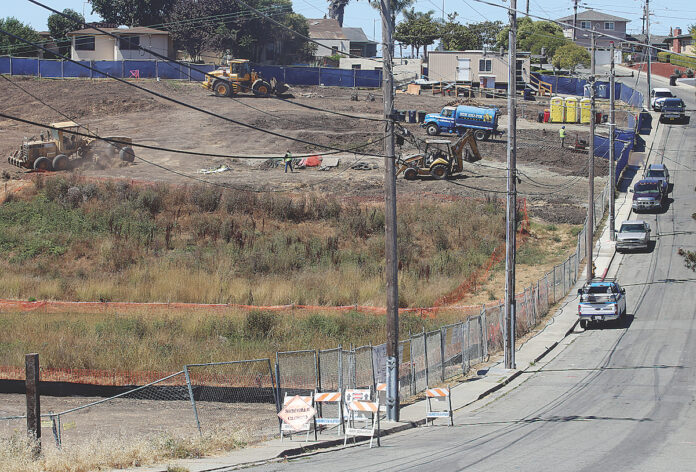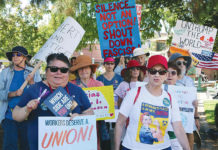
SANTA CRUZ COUNTY—There are many things that Santa Cruz County residents can boast about the place they live, including the astounding natural beauty and proximity to the coast.
But there is one aspect that will likely not be found on a tourism brochure, and will likely come as no surprise to residents: The region is the second least affordable place to live in the nation.
That’s according to “Out of Reach,” an annual publication of the National Low Income Housing Coalition, which shows the gap in every state between wages and housing costs.
According to the report, county residents need to make at least $60.35 per hour to rent a 2-bedroom apartment without spending 30% of their income. This number, known as the “housing wage,” is higher only in San Francisco, where residents must earn $61.50 per hour.
The statewide housing wage is $39.01, according to the report, while nationwide it is $25.82.
A closer look at the local data shows that the average wage for more than 38,000 county residents who rent is $19.78. With the fair market rate for a 2-bedroom apartment at $3,138, those workers must work four full-time jobs to afford rent.
Most families in the country, the report says, can afford to pay no more than $694 monthly rent, while people who rely on federal Social Security Income can afford no more than $252.
All of this comes as the median monthly rent in the most populated cities has for the first time exceeded $2,000, meaning that in only 9% of all U.S. counties can a full-time minimum-wage worker afford to rent even a one-bedroom home.
The report comes amid skyrocketing homelessness, rising inflation and gas prices and a looming economic recession that financial experts say is all but imminent.
The problem was compounded in 2020 when the CZU fires damaged or destroyed more than 1,600 structures, displacing hundreds of people.
The worsening affordable housing shortage is also compounded as emergency rental assistance programs run out of money, eviction moratoriums expire and renters face increases of 18% since last year.
Laws designed to boost minimum wages, meanwhile, are woefully inadequate, with the federal number stagnant at $7.25 per hour and in California at $15.
The crisis is worse among Black and Latino workers, who on average earn 23% and 25% less than the median white worker, respectively, according to the report.
The news locally is not all bad, with numerous affordable housing projects under development.
In Watsonville, this includes eight projects, including the 144-unit Hillcrest Estates on Ohlone Parkway, where 29 are slated as affordable. The South County city also plans 53 units at 1482 Freedom Blvd. and 72 units at 139 Miles Lane, all of which are affordable,
Santa Cruz has its own projects in the works, with 750 rental units in the city’s development pipeline, according to Santa Cruz Housing & Community Development Division Manager Jessica de Wit.
This includes the 831 Project, which when completed will contain 151 market rate, workforce and affordable housing units. Of these, 77 would be affordable, 47 very-low-income and the remainder being market-rate.
The Library Mixed Use project at the site of the downtown farmer’s market will include a new library, with housing on the upper floors with a minimum of 50 affordable units.
Housing Santa Cruz County on Wednesday announced that the county has received $16 million in annual fire recovery tax credits from the California Tax Credit Allocation Committee, which will allow 397 affordable housing units in Santa Cruz, Live Oak and Watsonville to break ground this year.
These include Pippin Orchards Phase II, an 80-unit apartment complex in Watsonville, a 57-unit development at 1500 Capitola Road in Live Oak and 65 apartments at Calvary Church in Santa Cruz.
“This additional federal investment in affordable housing is of great help, and we’re thrilled to see new shovel-ready affordable housing developments break ground,” said Santa Cruz County Supervisor Ryan Coonerty.
While such influxes of funding do happen, it is still a Sisyphean task to fund affordable housing, which carries the same costs as market-rate projects without private investment and bank loans, de Wit says.
“We have to leverage so many different sources of funding,” she said. “There are usually six or seven different sources.”
Don Lane, who chairs Housing Santa Cruz County, says the report is a reminder of the need for low-income housing projects, and for a sea change in the way those projects are viewed.
Instead of resisting these projects, he said, community members should acknowledge that many more affordable housing projects are needed, and then embrace them and find ways to make them work in their neighborhoods.
“The local government and the community needs to embrace the idea that we’re going to have more fights for affordable housing to be built,” Lane said. “And not resist so many projects, because historically that’s been one of the biggest challenges.”
Rafa Sonnenfeld, director of legal advocacy for Santa Cruz YIMBY, says that attitude change is urgent, as roughly 10,545 do not have access to an affordable home in Santa Cruz County.
As one of those renters, Sonnefeld says he has been waiting for a decade just to be put on a waitlist that has never opened.
“There just isn’t enough housing even when someone has a voucher,” Sonnefeld said. “That’s why Santa Cruz YIMBY advocates for housing for people of all income levels from low-income to market rate.”
YIMBY—an acronym for Yes In My Backyard—is a group that among other things supports new development.
Sonnefeld says that jurisdictions across the county are set over the next two years to update the housing elements of their general plans, with an increased capacity for housing in mind.
“That’s the most tangible way that jurisdictions in our county will be planning to provide more housing,” he said. “Literally change the zoning and change the general plan to allow this kind of housing to be built.”
Sonnefeld says that jurisdictions should move forward with an eye on “substantially large” apartment projects, with housing for everyone from low-income people to families to young professionals.
“We need it all,” he said.
Lane says the numbers mean that everyone must shift away from a business-as-usual approach to affordable housing.
“It’s really about how this current situation is hurting people,” he said. “It’s hurting families. It’s just causing so much strain on so many people individually, and right out of that comes the damage to the whole community when we have so many people struggling in it.”
For information on affordable housing projects in Santa Cruz County, visit housingsantacruzcounty.com/affordable-housing. To see the report, visit nlihc.org/oor.











